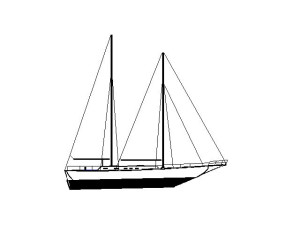Steel Schooner
75' x 36 Tons, Full Keel
28-Ft. Dia. Parachute Sea Anchor
Force 10-11 Conditions
File S/M-5, obtained from Jeremiah Nixon, St. Louis MO. - Vessel name Goodjump II, hailing port St. Louis, steel Schooner, designed by George Sutton, LOA 75' x LWL 62' x Beam 15' x Draft 6' 2" x 36 Tons - Full keel - Sea anchor: 28-ft. diameter C-9 military class parachute on 600' x 1-inch nylon three strand rode, with 5/8" galvanized swivel - No trip line - Deployed in deep water during a storm near 39° 50' N, 49° 30' W (mid-Atlantic) with winds of 60 knots and seas of 18' - Vessel's bow yawed 10° - Drift was about 18 n.m. during 18 hours at sea anchor
Goodjump II was sailing to Portugal from the U.S. east coast. The skipper, Jeremiah Nixon, had purchased a para-anchor from the author's company. It was a 28-ft. diameter C-9 military parachute, converted into a sea anchor. This parachute has been a staple of the Armed Forces for decades, and is still in use by the Air Force. You can tell a C-9 by the colors of the canopy, either red and white, or a combination of red, white, gold and olive drab. C-9s have 28 suspension lines.
Shane Victor has handled hundreds of C-9's to date, each and every time with awe and amazement. Little wonder World War II pilots used to refer to their parachutes as "silken angels." Light in weight, resilient and strong, a military parachute (not to be confused with lighter sport parachutes) embodies eighty years of development and refinement. Government contracts require that C-9 parachutes be able to negotiate dynamic loads of 5,000 lbs. without failure - they have to be test-dropped from aircraft flying at high speeds with dummies attached.
When Goodjump II ran into a storm in the middle of the Atlantic, the crew decided to put out the chute. They had some initial difficulty in getting the big canopy in the water. The wind took hold of it on deck and it was almost airborne . The crew persevered, however, and finally had the chute properly deployed on 600 feet of nylon rode. Goodjump II rounded up into the seas, her bow nicely snubbed to her parachute sea anchor in 18-ft. seas. Transcript:
The para-anchor worked perfectly, we rode nicely. Learned the hard way to deploy it from the windward side of the boat by pushing it right into the water while holding it against the side of the boat. It got loose on our first effort on the lee side and went into the air.
You asked the question of the angle and movement of our bow during the storm. I cleated the rode to the forward port cleat and as a result the bow held about 10° to the right of the wind and there was no swing from side to side that I noticed. In fact the deck was dry and there was no spray or pounding. The 600 feet of rode stretched and raised out of the water at the point of wave crest and then came back down with an easy controlled feeling.
We drank beer and ate chili during the worst and I got a solid 6 hours of sleep at a time when we had to wear a safety harness because of wind when we went forward to check on chafe.
No trip line is necessary. Just motor up to it and bring it up. These are some of the reasons why I consider this equipment the most important safety item on my boat.... I will never make an ocean passage without one on board. People must realize that ocean cruising can be safe if you go with the idea that you will go into a defensive position before the seas build too high. The flat-out philosophy of professional racers must be disregarded by the small crew cruising yachts
(Note: The problem of the wind inflating parachutes prematurely on deck can be minimized by wetting down the parachute beforehand. Nylon cloth is much more manageable and less likely to fly open in the wind when wet and heavy. The other alternative is to use a deployment bag.)
Love the Drag Device Database? Help us to keep it free for all mariners by making a tiny donation to cover our server and maintenance costs. Thank You!
